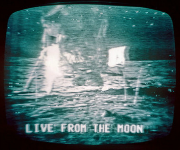|
For me is all about using a 24 disk striped array, that way if any disk goes bad I only lose a small chunk of my data.
|
|
|
|

|
| # ? May 23, 2024 18:49 |
|
Or just get Stablebit Drivepool and replicate your small amount of irreplaceable data onto every single drive in the array whilst JBODing the rest of the array to store your replaceable files.
|
|
|
Axe-man posted:I store my data on floppy disks that i keep in a drawer under the microwave. Try to steal that data hackers!
|
|
|
|
|
For those of you using Synology and B2, do you encrypt your data? Either through default encryption on the bucket or through the Synology integration?
|
|
|
|
i just plan on being crypto lockered as my data-at-rest solution
|
|
|
bobmarleysghost posted:For those of you using Synology and B2, do you encrypt your data? Either through default encryption on the bucket or through the Synology integration? I have veracrypt containers in my unencrypted backup volume which syncs to B2. I don't care about like, activities I made for grade 7s being encrypted but it would be a big deal to lose them and there's too much of that kind of thing to just keep in some cloud provider all the time.
|
|
|
|
|
Cross-posting from the enterprise storage thread because this one is more active. I'd love to hear your thoughts on front/rear 3.5 disk access vs top-loaders.Twerk from Home posted:What are the downsides of top-loading storage chassis vs front/rear in traditional chassis design? The top-loaders offer more disk bays per dollar, and take up less rack space per disk bay.
|
|
|
Twerk from Home posted:Cross-posting from the enterprise storage thread because this one is more active. I'd love to hear your thoughts on front/rear 3.5 disk access vs top-loaders. When you need to replace the disks, you're applying lateral forces to a gyroscopic object which causes gyroscopic precession, and the way the disks are usually aligned in the top-loaders (like in the second example you have) means that that force is applied to the mechanics of the drive in a way that's practically designed to do the most amount of damage possible. Best of all, it happens to all of the disks. BlankSystemDaemon fucked around with this message at 19:19 on Sep 24, 2021 |
|
|
|
|
Airflow is probably the main thing the front loaders have going for it as most drives are designed with it going over their long axis. However most new drives have heatsink fins that would allow airflow either way so itís probably less of a big deal now.  Top being a P4500, bottom being older P3500. This is nvme but sas drives are probably similar and also donít run as hot anyway.
|
|
|
|
Twerk from Home posted:Cross-posting from the enterprise storage thread because this one is more active. I'd love to hear your thoughts on front/rear 3.5 disk access vs top-loaders. The biggest downside is that you have to move all the disks to replace one, and most of the ones I've ever seen have the drives arranged so that movement is in the worst direction. They're really built for cloud scale environments where you'd just wait until enough disks failed in one unit and take the whole machine down for service/replacement. If you care about being able to hot swap individual disks you probably want to stick to the front/rear loaders. e:f;b
|
|
|
|
Is the radial vs axial force issue primarily a thing for doing drive swaps with the array powered on and in operation (as I assume an actual enterprise would)?
|
|
|
|
BlankSystemDaemon posted:but op, zfs has a minimum allocation size of 64mb Thats why they are all striped and I have 272 of them.
|
|
|
|
IOwnCalculus posted:Is the radial vs axial force issue primarily a thing for doing drive swaps with the array powered on and in operation (as I assume an actual enterprise would)? Correct. If the drives are off, then it doesn't really matter much if you're banging them around a little. But if you're the type of operation to need drive density that high, you also almost certainly are the type of operation that isn't keen on powering down 30+ drives to replace a single one.
|
|
|
|
BlankSystemDaemon posted:The big downside to top-loaders is something I've mentioned before. Thanks, I saw you allude to having to move all of the drives as a downside, but I didn't realize that it was hard on them / potentially damaging to move spinning disks on that axis, just thought it was physically a pain to deal with moving the chassis and having it installed correctly to be able to slide into the service position while online. The top loaders do have hot-swap bays in there facing the top, so I assumed they were designed to be used! Top-loaders seem better suited to solutions that's more designed to run forever without replacing dead drives like Ceph, where you can just throw more nodes on to grow horizontally and there's never really a reason to replace dead disks, vs something like ZFS where internally there's going to be a topology based on vdevs of raidz2s and one is having to worry about keeping every vdev healthy, even in case of clustered disk failure. You also referred to grouping multiple vdevs together to allow hot spares to be shared between them, so that some hot spares could be included in the original design. I guess hot spares could be planned out so that actually having to go replace a disk becomes something unusual, but then you get lower utilization out of the whole thing. The other option is paying the extra expense and space to do 36-bay plus 12-bay JBOD chassis as needed to extend, which isn't all that much more expensive overall. I haven't thought much about how much you can over-subscribe an SAS controller, time for me to try and learn about something else new to me. These big storage chassis from Supermicro seem wildly oversubscribed in the first place, that 45-bay top loader that I linked has 45 disks on a single 8 channel SAS controller, while stuff like Storinator chassis will use 3 16 port SAS controllers. Hard disks are nowhere near saturating 12Gbit SAS 3 anyway, is running 45 disks on 8 SAS ports like that 45-bay Supermicro does just fine, like I'm assuming? Why is Storinator doing the extra expense to use a ton of SAS controllers instead of SAS expanders? For people running external JBOD chassis, how far are you oversubscribing them? Edit: It looks like Supermicro supports daisy chaining those backplanes, putting 90 disks on 8 SAS ports as a config that they suggest would be fine? More than 11 disks per SAS port! Twerk from Home fucked around with this message at 05:28 on Sep 25, 2021 |
|
|
|
bobmarleysghost posted:For those of you using Synology and B2, do you encrypt your data? Either through default encryption on the bucket or through the Synology integration? Yes, I use the synology B2 integration/cloud sync to encrypt the data on the NAS before it gets uploaded. I'm not sure if that is the best way or not, but it works for me.
|
|
|
|
droll posted:I thought NAS would make it easier to share content with my fellow travelers and family/friends along the way, rather than everyone having to connect and copy the data off. Is that the best RAID enclosure you recommend? I feel that it very much depends on the usage scenario. USB enclosures are simple, everyone can use them and they just work. Biggest downside is that only one computer can use them at a time, unless you use network sharing on your computer to share it with others. NAS are a bit more complicated and they have more requirements to work, and if you are travelling with it you may not be sure if all the situations satisfy those requirements. For example if you plugged in the NAS to the network at my work you might be surprised when nothing happens. The NAS would not get network access and it would inaccessible for you. Similarly if you plan to use it in hotels, most NAS devices are designed to be plugged in to wired ethernet network and nowadays most hotel rooms won't have one of those and homes may not have it either. Most places use wireless and it's far from trivial to connect a NAS to wireless network. You may also need to bring a router or switch with you for connecting the NAS and your computer, and in my experience it can be surprisingly difficult to connect a Win10 computer simultaneously to WiFi for internet access and ethernet for the NAS.
|
|
|
Axe-man posted:Thats why they are all striped and I have 272 of them.
|
|
|
|
ROJO posted:Yes, I use the synology B2 integration/cloud sync to encrypt the data on the NAS before it gets uploaded. I'm not sure if that is the best way or not, but it works for me. It's better to encrypt before you send so that the cloud provider never has the key to unlock your data.
|
|
|
|
|
ROJO posted:Yes, I use the synology B2 integration/cloud sync to encrypt the data on the NAS before it gets uploaded. I'm not sure if that is the best way or not, but it works for me. I read into the cloud sync encryption and there was a blurb that you are only able to decrypt the data using cloud sync, so I'd be locked in to Synology and cloud sync. That's a little iffy for me.
|
|
|
|
Axe-man posted:I store my data on floppy disks that i keep in a drawer under the microwave. Try to steal that data hackers! Are you sure? A skinny man in a black hoodie gave me this.  Also, newegg's got 12TB Elements drives for $200 with a promo code: https://www.newegg.com/black-wd-elements-12tb/p/N82E16822234406?sdtid=15297367&Item=N82E16822234406 Promo code: EMC2AZ92467 from: https://slickdeals.net/f/15297367-12tb-wd-elements-usb-3-0-desktop-hard-drive-200-at-newegg?src=frontpage https://shucks.top/ has the lowest price recorded as $179.99 302 days ago.
|
|
|
|
Rexxed posted:Also, newegg's got 12TB Elements drives for $200 with a promo code: Thanks, was gonna hold out until they hit $180 again but that's close enough for me.
|
|
|
|
Enos Cabell posted:Thanks, was gonna hold out until they hit $180 again but that's close enough for me. Same, but who knows when.
|
|
|
|
bobmarleysghost posted:I read into the cloud sync encryption and there was a blurb that you are only able to decrypt the data using cloud sync, so I'd be locked in to Synology and cloud sync. That's a little iffy for me. You can decrypt it using a synology tool that runs on a regular computer - obviously you need to have access to the tool (I have backup copies of that stored elsewhere in case it ever disappears), but you don't need an actual functioning synology box to do the decrypt. I think I also looked into it originally (because I was a little miffed by the concept of a proprietary tool) - and I seem to remember finding someway to also do it with linux commands or something, but it was a little over my head and I have since forgotten.
|
|
|
|
Yeah I was concerned about it too but the backup is so good in terms of being able to browse snapshots in the calender and pick out individual files. It's genuinely a great tool and as stated can be run on a separate machine.
|
|
|
|
A different drive deal today, no shucking. Toshiba Enterprise 14TB (7200 RPM and 5 year warranty) for $279.99 with promo code at newegg: https://www.newegg.com/toshiba-mg08aca14te-14tb/p/N82E16822149785?sdtid=15301924&Item=N82E16822149785&Tpk=22-149-785 Promo code: SCALZ927D from: https://slickdeals.net/f/15301924-t...er-code?src=pdw
|
|
|
It looks like the talk list for the 2021 OpenZFS Developer Summit has finalized:
|
|
|
|
|
This is probably not the correct thread but I have a hard disk question. I have and old disk I'm trying to transfer data from. What I'm finding is that some files inside are causing Windows Explorer to hang/go unresponsive when I try to interact with them. For example if I tried to copy and paste them to another location it'll pop up the "searching for files" window but never gets around to transferring, or it simply does nothing. It'll eventually cause Explorer to do the neverending green loading bar when I try to view any window that contains that particular drive. There's no particular pattern to the afflicted files and I can manipulate the unaffected files as normal. Some of them are images, isos, videos, exes and pdfs. I've run diagnostics with checkdisk and seatools but haven't found any errors. None of the files are irreplaceable and I'm about to trash the drive anyway as its 11 years old but I wanted to see if there was a anything I was missing before I give up and bin everything.
|
|
|
|
If you run HDD Guardian or Gsmartcontrol, can you find the S.M.A.R.T attributes, save them to a textfile and/or pastebin, and link that here? I'm specifically looking for the raw values of the attributes, because those're the only real indicator of anything being wrong (the normalized values aren't worth much).
|
|
|
|
|
BlankSystemDaemon posted:If you run HDD Guardian or Gsmartcontrol, can you find the S.M.A.R.T attributes, save them to a textfile and/or pastebin, and link that here? Is this it? https://pastebin.com/YhMsenus I'm no expert but it looks fine?
|
|
|
|
Z the IVth posted:Is this it? The load cycles are very high, so I wonder if there is something wrong with the arm reading the disk platters. Greens were notorious for parking the drive at every opportunity to save power. They even had a script you could run early on that reduced the load cycles. Is there any noticeable clicking noises while the drive is trying to read data?
|
|
|
|
Nulldevice posted:The load cycles are very high, so I wonder if there is something wrong with the arm reading the disk platters. Greens were notorious for parking the drive at every opportunity to save power. They even had a script you could run early on that reduced the load cycles. Is there any noticeable clicking noises while the drive is trying to read data? It clicks when it starts to read but not continuously.
|
|
|
Z the IVth posted:Is this it? Having said that, other than the LCC that's already been mentioned as being suspiciously high (which I would guess would be because of the disk being configured to spin down when idle when it was still being used), the UDMA_CRC_Error_Count is higher than one might expect, and is usually indicative of a bad cable, which could be the underlying cause for the symptom you're describing (or it could just be a confounding factor - without a filesytem like ZFS, it's basically impossible to tell). Do you have a known good cable you could replace it with, or can you at least try reseating it at both ends? Do you have the option of creating a whole-disk image onto a bigger newer drive?
|
|
|
|
|
I'm hoping someone can offer some reassurance on migrating between Synology Diskstations without data loss I'm currently on a DS220+ mounting a pair of 10TB WD Red Plus in RAID 1 in Btrfs. Also in there is a stick of 8GB DDR4. The volume is currently at 95%. I don't have anywhere to put this data that's not on the NAS it currently lives on. I plan to purchase either a DS420+ or a DS920+ (Does anyone actually use the expansion devices?) as well as another pair of 10TB WD Red Plus drives. Ideally I would switch to RAID 5 on the new appliance to triple my storage without losing single disk loss protection. The tutorial on the Synology site suggests I can just swap the drives over and restore the configuration and it will work. But I'm as not clear how changing the RAID types will work? will I be able to add the new drives to the pool once the two old drives are up and running in the new 4-bay device? I get that I can't run RAID 5 without 3+ drives... but I guess I'm unclear how hazardous adding the new drives to the pool will be.
|
|
|
|
BlankSystemDaemon posted:Yep, that's it. In an ideal world, there would be historical logging (or better yet, graphical charting) of this data everywhere, because it's surprisingly useful when charted properly. I've actually just rebuilt my system and I used the same cable on a different drive which didn't cause any problems. I recall a drive in my old system acting funky which prompted me to get some SSDs and I suspect this was the one. Is there any guarantee trying to make a disk image would work or will it just choke? The drive partition is like 400gb so it's sizeable.
|
|
|
|
Sir DonkeyPunch posted:I'm hoping someone can offer some reassurance on migrating between Synology Diskstations without data loss You should be able to migrate the disks over like you said, the OS is on the disks themselves, so that part should be very straightforward. Going from RAID-1 to RAID-5 is also easy. Shouldn't be any issues. Of course, you should already have a backup of this data, but yeah. https://kb.synology.com/en-global/DSM/tutorial/Why_cant_I_change_RAID1_to_SHR_or_vice_versa https://kb.synology.com/en-us/DSM/help/DSM/StorageManager/storage_pool_change_raid_type?version=6
|
|
|
|
Z the IVth posted:It clicks when it starts to read but not continuously. I would guess it's a dying drive, rather than the cable. If I were wedded to the data on it, I'd be using ddrescue to image the drive onto another, as best as it can. Then I'd be extracting all I could out of that image. Imaging the drive is a day+ affair and requires an equal-or-bigger drive spare, so if you're not wedded to it I'd consider how much effort you're willing to put in.
|
|
|
Z the IVth posted:I've actually just rebuilt my system and I used the same cable on a different drive which didn't cause any problems. The advantage of doing a low-level whole-disk mirroring process onto another drive is that there are tools which are designed to never give up. One of my fellow FreeBSD committers wrote a tool for FreeBSD which will keep retrying to grab data in various patterns until it either succeeds or is stopped manually - and not long ago he mentioned that someone had had it running for over 3 years before it completed successfully. The problem, of course, is that Windows doesn't really expose the same low-level disk access as FreeBSD does, and while Linux sort of does, you have to do a bit of hoop-jumping with the equivalent tools like ddrescue and and the way Linux exposes raw devices, and I'm not well-versed enough to feel comfortable guiding you through it for Linux, if that's something you'd be interested in trying.
|
|
|
|
|
Thanks for the advice and tips. I think I'll just redownload the files if I ever need them again. Another question - I have 2x 120Gb SSDs left over, is there anything useful I can do with them? I am toying with the idea of a raspberry pi NAS (I have one lying around). Is it a waste of time?
|
|
|
|
Nam Taf posted:I would guess it's a dying drive, rather than the cable. If the most important data is only a small portion I might first try to copy single files and directories before continuing with ddrescue.
|
|
|
|

|
| # ? May 23, 2024 18:49 |
Z the IVth posted:Thanks for the advice and tips. I think I'll just redownload the files if I ever need them again.  One of the few use-cases of SSDs are being able to satuate 10G SFP+ networking, but since the RPI can't do that (not even the newest ones, let alone the ones where the networking 1000BaseT PHY is attached via USB2, limiting it to 480Mbps, or under half of wirespeed) - so outside of desoldering the USB3 controller on a RPI4 and replacing it with a PCI controller to get a 10G SFP+ interface on it, it doesn't seem like there's much point.
|
|
|
|












































